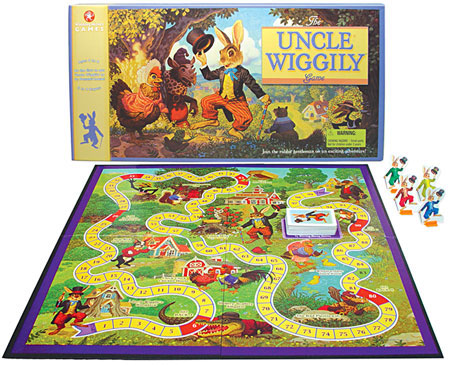Tabitha was years old when we were playing a game of Uncle Wiggily.

In case you are not familiar with the game, I’ll briefly describe it. Uncle Wiggily is a board game with 100 spaces along a twisty path. Players draw cards; each card has a number and a brief poem. Perils and bonuses are judiciously spaced along the path. Uncle Wiggily is approximately 10% more complicated than Candy Land (which is to say, not very complicated at all!)
Tabitha: (Drawing a card for her first turn-it’s an 8) Got one Daddy!
Me: Mmm-hmmm.
T: What is it?
Me: Can you guess? Look closely.
T: (Quickly and with a big, eager smile on her face) Six!
Me: Good guess. It’s eight.
T: Oh!
Me: Can you count to eight?
T: (Bouncing her piece along the path, ending near the henhouse on the farm-themed board) One, two, three, four, five, six, seven, eight. By the cluck-cluck house!
Me: My turn. (Drawing a card-it’s a 10) What card did I choose?
T: Ten!
Me: Good. (Testing a hypothesis, I skip eight as I count) One, two, three, four, five, six, seven, nine, ten.
T: (Oblivious) My turn.
So what do we learn?
Learning to count is messy. Many things we might expect to be true about how children learn to count are not true at all.
We might expect children to learn the numerals (8) at the same time that they learn the words (eight). They do not. Notice that Tabitha counted flawlessly to eight, but did not recognize the symbol “8”.
We might expect children to learn the numerals in order, with all multi-digit numbers coming only after mastering the single-digit numbers. They do not. Tabitha recognized “10” but not “8”.
When I counted to ten, I intentionally left out eight to see whether she would notice. She did not. She could count to eight, but didn’t notice when it got left out on the way to ten. Mathematics is logical and orderly. The ways children learn mathematics are not.
This conversation came from a short video I made one day. I watched this video a year and a half later, when Tabitha was 5. After watching it, I immediately went into the kitchen where she was having a snack and counted: 1, 2, 3, 4, 5, 6, 7, 9, 10. She smiled and asked Why did you do that? (referring to counting in her ear). Then, a moment later, she said, Hey! You skipped eight!
Starting the conversation
Play games that involve numbers. Uncle Wiggily is great. So is Chutes and Ladders. Or Hopscotch. Any game that involves counting and reading numerals will give you the chance to practice these early number ideas.
While you’re playing, ask your child what number he drew, and what number you drew. If he doesn’t know, have him guess. Don’t worry about precision or correctness. Model good counting for your child. Help him count out some of his turns and let him count incorrectly on others. Have fun and don’t worry too much if he gets bored before the game is finished.
Have fun with it. Whatever you need to do to stay engaged in a couple of rounds of Uncle Wiggily is worth the effort. You can see the effort I invested in keeping myself entertained; I formulated a hypothesis about whether she would notice my own incorrect counting and tested that hypothesis.
Don’t get carried away with the hypothesis testing, though. Children do need models of correct counting. They won’t be damaged by a few experiments, of course. But you don’t want to become an unreliable source of knowledge.
